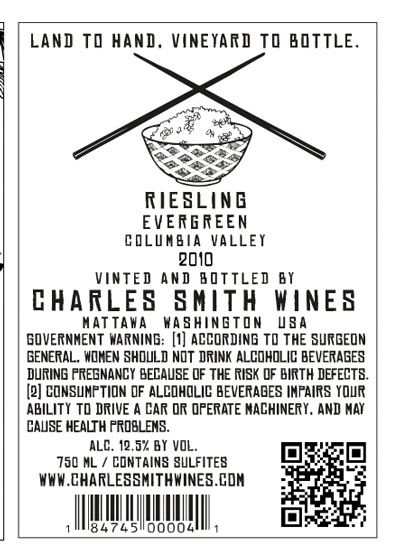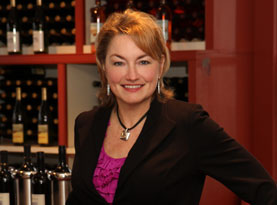Why Buy Local Wines?
Why should consumers buy local wines? To support the community, to be a locavore, to support their local grape growers and wineries? Yes, yes and yes. But even more importantly, because your local wines are absolutely delicious! Midwest wines are getting better and better every vintage. From hybrids to viniferas, the wineries of the Midwest are constantly and consistently improving their wines.
As wine consumers, we have a plethora of choices. From Albarinos from Spain to Nortons from Missouri, the range of selections can be daunting for many wine drinkers. Don’t be discouraged, there are lots of choices from your neighbors’ wineries right here at home. Does this mean we should drink inferior wine just because we want to support Midwest wines? Absolutely not.
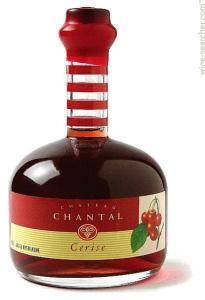
Not only is the label attractive, the entire package is distinctive
The Old World (Europe) has been producing wine for centuries. Grape growers and winemakers there have learned from their mistakes as well as their triumphs over the years. They have a few hundred years head start on Midwesterners. California has been producing wine since Father Junipero Serra first planted vines in the 1700s. We’re doing just fine, we’re actually ahead of the curve, due to the benefits of technology.
Grape growing and wine making are a cuvee of art and science. Trial and error are part of the equation. What to plant where? How to train the canopy? When to harvest? These are just a very few of the questions demanding answers before the wonderful elixir we call wine is enjoyed by the increasingly particular public.
I know a ten dollar bottle of Riesling from California is going to be a fruity, tasty and remarkably consistent bottle of wine. Why choose a Riesling from the Old Mission Peninsula in northern Michigan? That attractively packaged big brand bottle is a good bang for my buck. Why take a chance on that Michigan Riesling? Why not, it may be a couple of dollars more than the California product but odds are it will have exponentially more character than its California counterpart. Why roll the dice on a Missouri Norton instead of an Argentinean Malbec? Easy, because that Norton will open your eyes and palate to a flavor profile unique to its terroir!
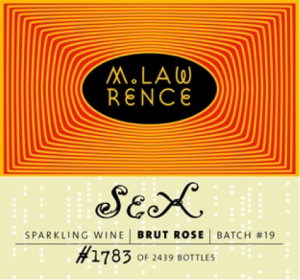
Larry Mawby’s fun sparkler- sex sells!
Product quality is paramount. Packaging, placement, and marketing are also critical to spreading the word about Midwest wines. If your wine is technically perfect and varietally correct, but has a cheap-looking label, no shelf talker and is on the second to the bottom shelf at your local retailer, guess what-you’re not going to reach your sales goals!
You don’t need to spend a fortune on focus groups to know that your label is crucial to your commercial success. Tell your story on your label. The more information you include the better. If your business is a family affair, let us know who is involved. If there is a long history behind your operation, please, tell us the story. If your grapes are sourced from specific vineyards, share that with us. What’s unique about your wine?
Is your bottled pride and joy easy to find on the retailers shelf? When consumers gaze at the ‘wall of wine” in their favorite store or local supermarket, they’re frequently dazed and confused. So many wines, so little familiarity with most of those products. Your challenge is to somehow, some way, get your wine on the eye-level shelves. This is pivotal in ‘getting eyeballs” on your wine. The politics of shelf positioning is a pain, to say the least. You’re competing with mega-corporations and the store buyer’s ‘friends and family”, not to mention folks whose cold hard cash gets them premium placements.
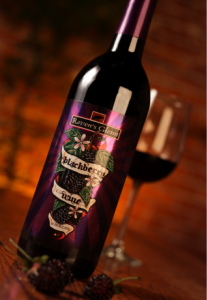
Raven’s Glenn from Ohio- The berries on the label look good enough to eat.
A classic tactic to promote your wine is the use of shelf talkers. These little printed cards attached to the shelf below your product are a very powerful tool in marketing your wine. Describe your wine, suggest food pairings, tell the consumer what you want them to know about your wine! As a former retailer and distributor, experience taught me the power of shelf talkers.
It’s your job to persuade wine drinkers to choose local instead of, or in addition to, those brands they see advertised every day. The cliché, ‘we like that to which we are accustomed” holds true today. Once your customer tries and enjoys your wine, they’ll be back for more. Is price important? Of course it is! Consumers shop with a price point already in mind. They’re looking for a fifteen dollar bottle of Chardonnay. You need to convince them your Vignoles for eighteen dollars a bottle is a better value for all the right reasons.
Most people are predisposed to buy local products, even if it costs them a bit more than that Australian wine with the kangaroo on the label. Capitalize on that mindset to develop loyal fans for your wines. While packaging and promotion are important, the ultimate criteria is inside the bottle. Combine your delicious wine with an effective marketing plan to build your brand!
©2012 Wine Counselor LLC
Michael Schafer Esq., The Wine Counselor®, is a wine educator, speaker, Sommelier, C.S.W., writer and consultant who entertains while educating. His approach to wine is reflected in his trademark phrase, ‘I taste bad wine so you don’t have to”®
For more information see: www.winecounselor.net


